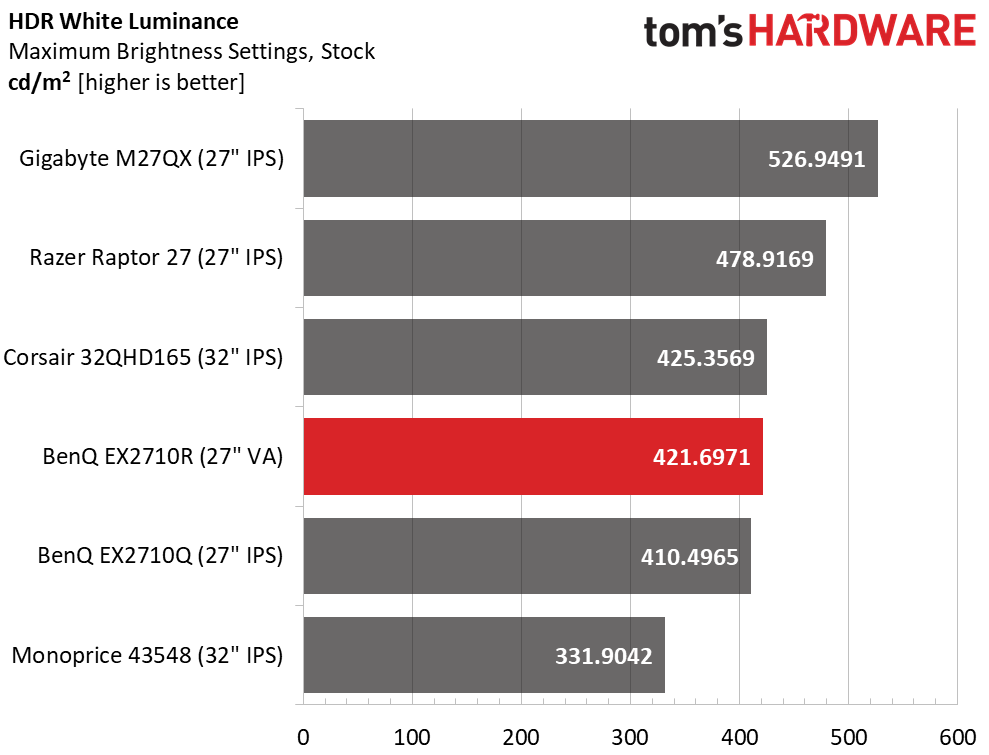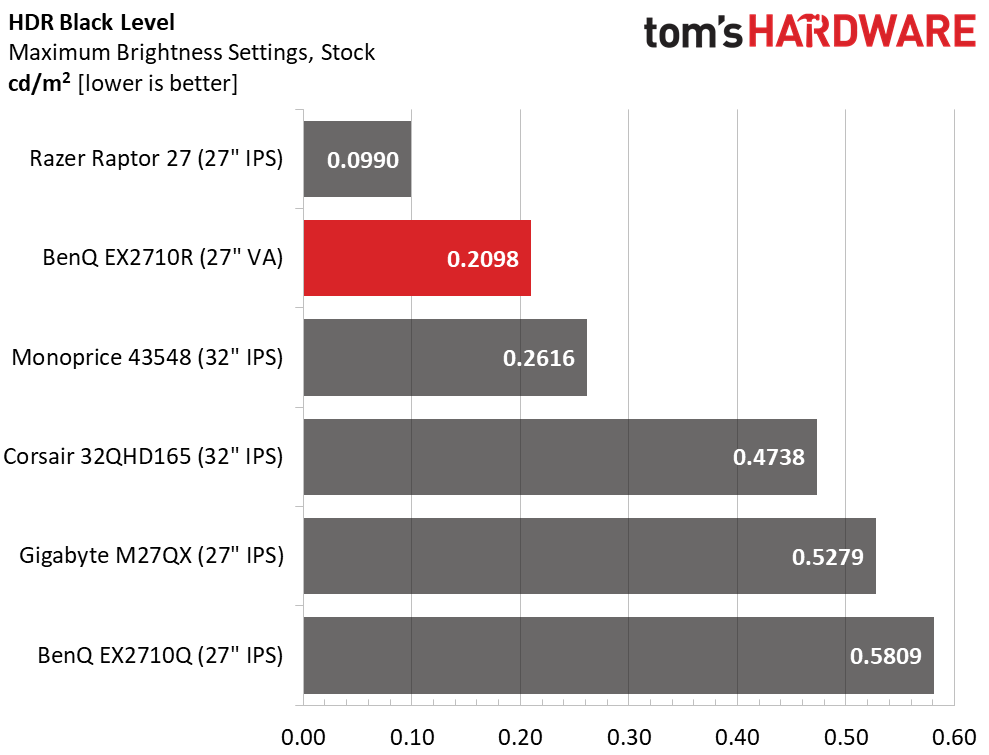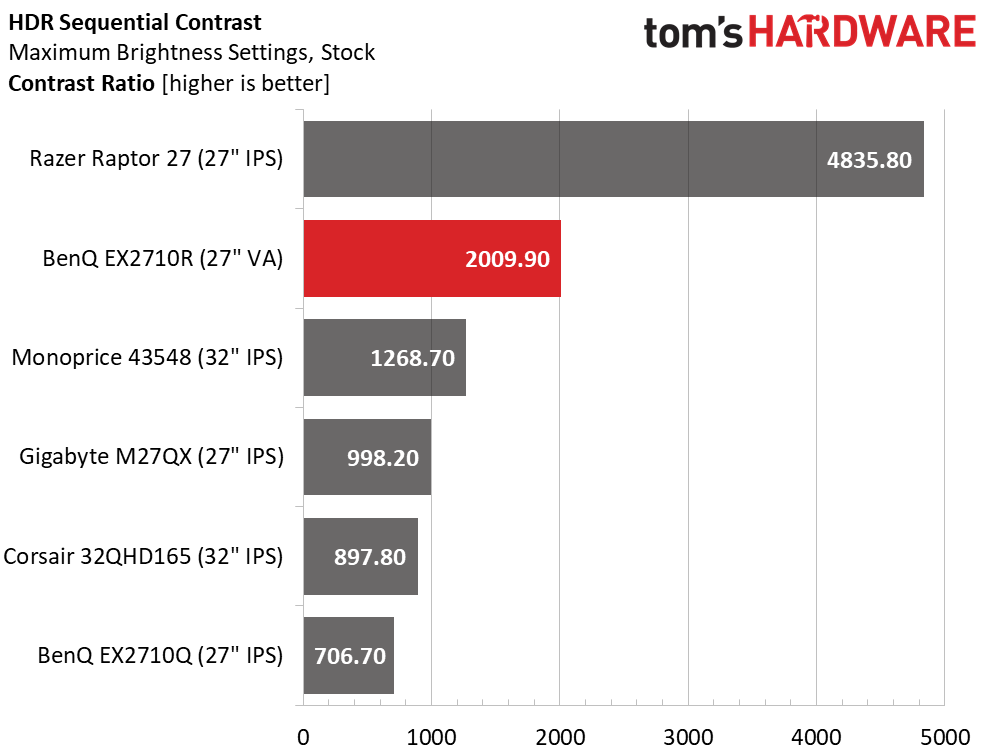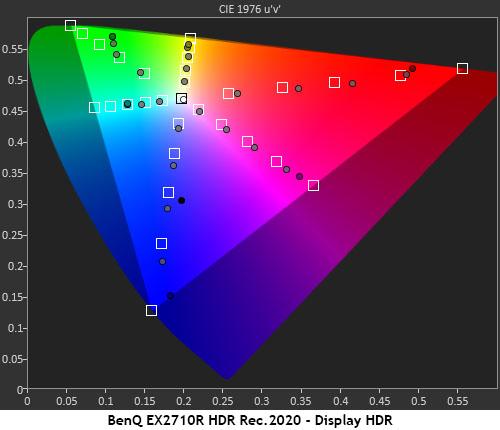Why you can trust Tom's Hardware
Our HDR benchmarking uses Portrait Displays’ Calman software. To learn about our HDR testing, see our breakdown of how we test PC monitors.
The extra contrast available in the EX2710R over the EX2710Q makes it a far better HDR screen. Though the difference between HDR and SDR isn’t huge, it still qualifies as better than average.
HDR Brightness and Contrast



The EX2710R easily tops its DisplayHDR 400 certification with just over 421 nits. That’s plenty bright and it creates highlights that pop. With a low black level, it delivers decent contrast at around 2009.9:1. I was disappointed to see that score come in lower than the SDR ratio. That puts it on par with other VA monitors that don’t have dynamic contrast features. It is at least better than the other IPS screens here save the Razer, which does have dynamic contrast. If you’re choosing between the EX2710R and EX2710Q, pick the R for its better HDR image.
Grayscale, EOTF and Color



In the grayscale test, the EX2710R shows some slightly visible blue errors in the darkest steps. This contributes to its black level, which could be lower. You can also see in the EOTF chart a slight rise in the white line at zero and 5%. This is a luminance tracking error that reduces dynamic range. BenQ could address this with a firmware update, and it would likely raise the HDR contrast ratio to at least 3,000:1. The good part is that tracking from there is nearly perfect. The transition to tone mapping happens smoothly at around 65%, also ideal for a 400-nit monitor.
In the HDR gamut tests, I compared DCI-P3 and Rec.2020. DCI is a bit over-saturated, which isn’t a bad thing. HDR color is definitely more saturated than SDR. The EX2710R nearly fills the gamut but comes up a tad short in green, like most wide-gamut screens. In the Rec.2020 run, it tries to up red and green hues to fill in the missing color. The net effect is positive, with rich hues in all the HDR content I viewed.
Get Tom's Hardware's best news and in-depth reviews, straight to your inbox.

Christian Eberle is a Contributing Editor for Tom's Hardware US. He's a veteran reviewer of A/V equipment, specializing in monitors. Christian began his obsession with tech when he built his first PC in 1991, a 286 running DOS 3.0 at a blazing 12MHz. In 2006, he undertook training from the Imaging Science Foundation in video calibration and testing and thus started a passion for precise imaging that persists to this day. He is also a professional musician with a degree from the New England Conservatory as a classical bassoonist which he used to good effect as a performer with the West Point Army Band from 1987 to 2013. He enjoys watching movies and listening to high-end audio in his custom-built home theater and can be seen riding trails near his home on a race-ready ICE VTX recumbent trike. Christian enjoys the endless summer in Florida where he lives with his wife and Chihuahua and plays with orchestras around the state.
-
shaolin95 "ANSI contrast is only a tad lower at 2,632.9:1. It truly doesn’t get much better than this without enhancements like full-array zone dimming or some sort of dynamic contrast option. The EX2710R delivers a deep, colorful image with rich saturation and realism. "Reply
That does not make sense. You clearly have other VA panels without those features that are hitting much higher than that like the Dell 3220 or 3222dgm. -
edzieba ReplyHDR contrast is lower than SDR
So the Dynamic Range in High Dynamic Range mode is smaller than the Dynamic Range in Standard Dynamic Range mode. A further illustration that "HDR400" can be read as "this display is not HDR in any way shape or form".
A display merely supporting a HDR input signal and then displaying it in SDR is as worthless as the old panels that accepted a 1080p input and displayed it on a 480p panel: at best making 2HD support" a completely lie, and at worst making the image worse by instructing the source device to send a signal the panel can't properly display rather than one it can. A clipped or crushed (in terms of dynamic range) HDR image on an SDR panel will always look worse than a properly mastered SDR image on that same panel.